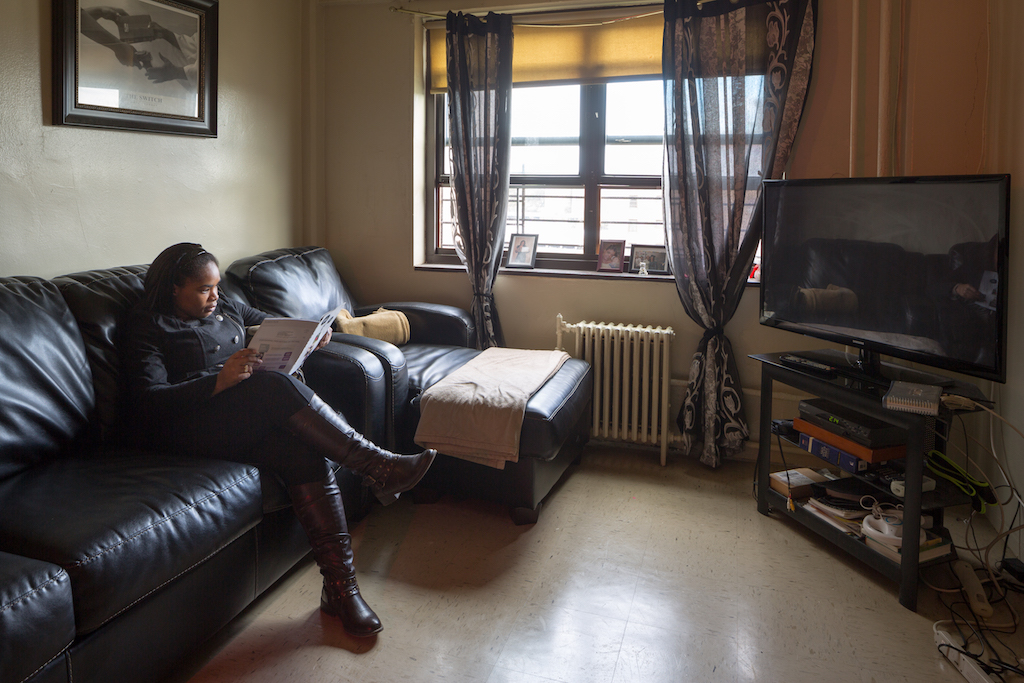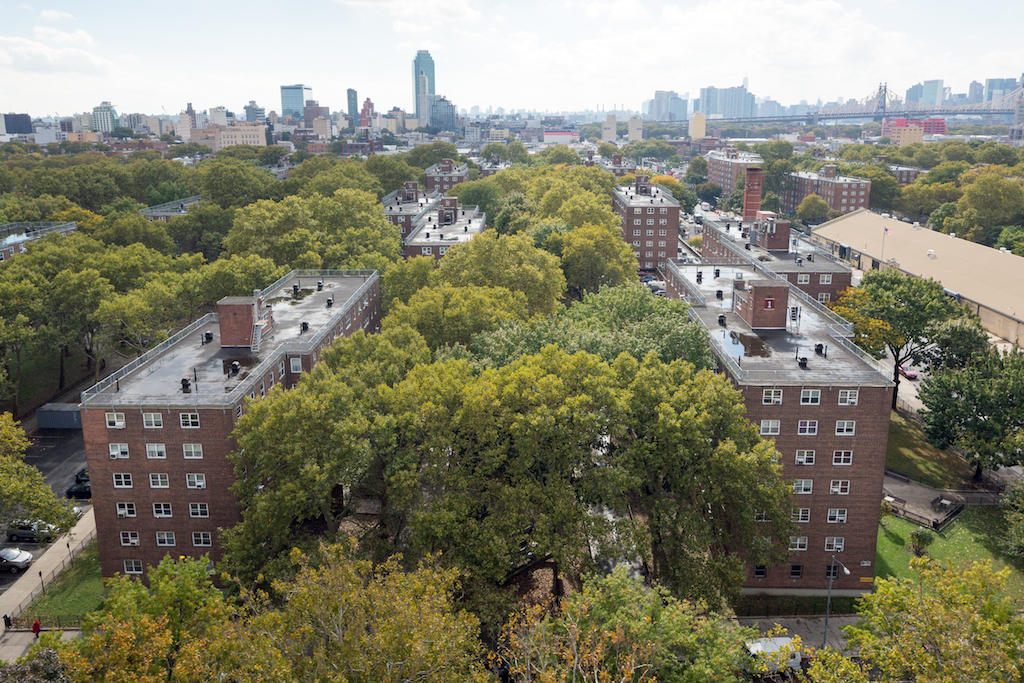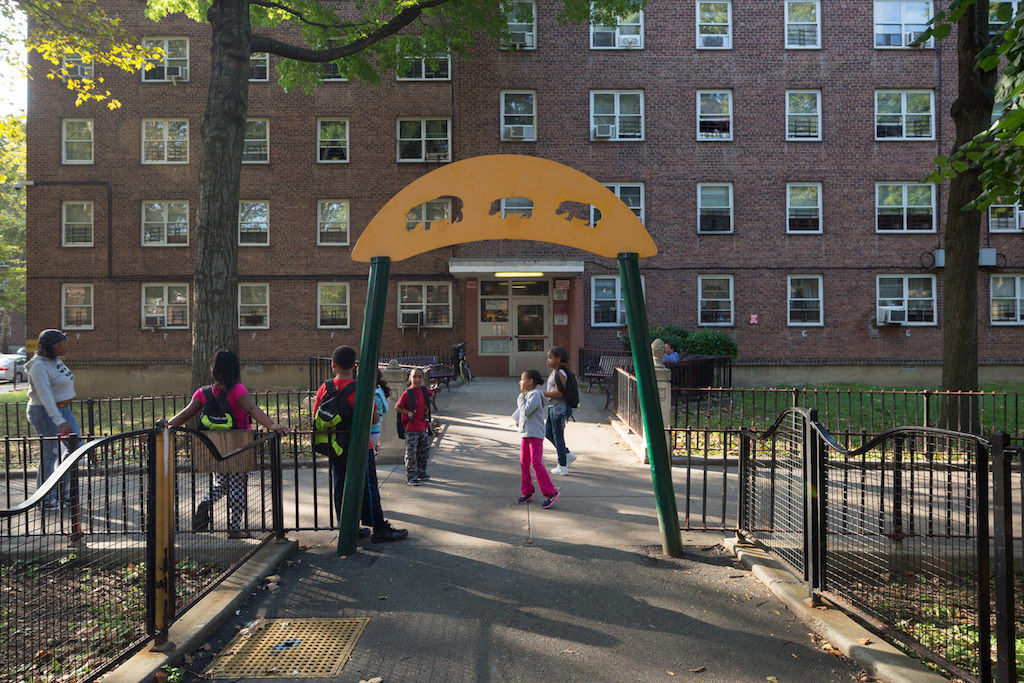Housing Brass Tacks
Reports from a series of informal conversations with scholars and experts engaging complicated topics in housing policy, hosted by The Architectural League.
We are celebrating 15 years — and counting — of stories that are deeply researched and deeply felt, that build a historical record of what the city has been.
In our seventh Brass Tacks discussion, Rasmia Kirmani-Frye, President of the Fund for Public Housing and Director of the Office of Public/Private Partnerships at the New York City Housing Authority (NYCHA), leveled with us on public housing’s unique role in the city and the challenges NYCHA must face.
Public housing in New York City constitutes a city within the city. With 176,066 units in 2,462 buildings distributed across 326 developments throughout the five boroughs, the New York City Housing Authority (NYCHA) is the largest landlord in North America. NYCHA houses more people than the cities of Atlanta, Miami, or Boston. NYCHA is home to 1 in 14 New Yorkers: 590,216 people including Housing Choice Voucher (Section 8) holders; of these more than 400,000 live in NYCHA complexes.
The residents of this city-within-a-city defy negative stereotypes. The majority of NYCHA residents are working families: 54 percent of non-disabled working-age adults are employed, and only 13 percent of residents receive public assistance. But it’s true that NYCHA provides a home to the most vulnerable New Yorkers, including older people (approximately 77,000) and children (approximately 110,000). NYCHA provides a keystone of affordable housing in New York. When the average NYCHA household nets only $23,300 per year, a payment structure that caps rents at 30 percent of a family’s income makes the difference between sustained affordability and homelessness. The line at the gates is long: there are more than 200,000 people on the waitlist. Rather than a drain on the city, as it is sometimes characterized, Kirmani-Frye advocated viewing public housing as an asset. “It would be devastating to the city if public housing went away,” she said. NYCHA contributes $6 billion to the city and state economies annually, and, Kirmani-Frye reminded, “In a city whose income gap keeps growing and growing, public housing provides racial and economic diversity in New York City.”
NYCHA = New York's "Public" Kirmani-Frye’s vision is to bring public housing out of the shadows and into the public sphere that New Yorkers celebrate — and want to invest in. “New Yorkers do really understand the value of and feel connected to systems with the word ‘public’ in front of them: public transportation, public education, public art,” Kirmani-Frye said. “But not in the same way with public housing. But it’s the residents of public housing that make all of those systems, which we claim to love, run.” Nine out of the top ten employers of NYCHA residents are public systems. NYCHA itself is one of the top three employers of public housing residents — the other two are the New York Police Department (NYPD) and the New York City Department of Education. “It’s the guy who cleans the subway every day, it’s the school bus driver, it’s the crossing guard, it’s the cop,” Kirmani-Frye said.
NYCHA’s $3.2 billion annual operating budget matches the sprawl of its portfolio. But while cities can draw on booming business districts and flowing tax revenue for funding, NYCHA depends on governmental allocations. Perhaps counterintuitively, less than 10 percent of NYCHA’s funding comes from New York City municipal sources. In fact, NYCHA is not a municipal agency but rather a state “public benefit corporation.” More than 60 percent of the money NYCHA has to work with comes from the US Department of Housing and Urban Development (HUD) in the form of Section 8 vouchers and federal operating subsidies; rental income provides most of the remainder.
As NYCHA’s buildings age and federal funding slows to a trickle, chronic budget shortfalls have become the norm. Federal funding for public housing construction and operations has steadily run dry under both Republican and Democratic administrations since the mid-1970s. Since 2001, deepening cuts to NYCHA’s federal and state subsidies have amounted to a $1.6 billion loss in funding for operating services, alongside a loss of $1.4 billion in funding for management and staff. Now, NYCHA’s buildings average 60 years old and, at this point, it would cost $17.1 billion to make the infrastructure seaworthy. To make matters worse, Superstorm Sandy delivered the worst blow to NYCHA’s buildings in the Authority’s history, wreaking $3 billion of damage in total.
With NYCHA’s operating reserves all but depleted, essential repairs now go unperformed and important contingency funding has evaporated. Ironically, thorough repairs and renovations would make the system significantly cheaper to run. The Authority has found itself making impossible choices about how to ration profoundly insufficient resources to patch up its massive properties. Reports of extreme decay — ranging from mold from ruptured roofs and broken appliances, to burst pipes, crumbling plaster, and shorted electricity — persisting for months or even years without intervention, abound in the press. “It’s beyond triage,” NYCHA Chair Shola Olatoye told the New York Times in 2014.
Diversity = Difficulty Soaring red and brown brick towers dominate NYCHA’s public image. NYCHA's explosive postwar growth period favored tower-in-the-park schemes for the sake of efficiency and high unit counts. Mostly well-built and designed with care by firms such as Skidmore, Owings, and Merrill, and prolific architects such as H.I Feldman, the buildings’ designs have made New York City public housing architecture iconic. In reality, NYCHA's portfolio is much more diverse than the public’s impression allows: Brooklyn's Marcus Garvey Village and the Bronx's Clason Point Gardens have provoked much theorizing on the value of low-rise housing in architecture and urban planning circles. The Authority's 36 brownstones were rehabilitated as part of Robert Moses's Upper West Side urban renewal plans. The Betances Houses, 900 apartments spread over dozens of new and rehabilitated buildings in Mott Haven, are one of the legacies of the Great Society-era Model Cities program. Diversity has its drawbacks: small-scale housing presents maintenance and security challenges. The more than 700 FHA-repossessed single-family and small multi-family homes that HUD transferred to NYCHA in the 1970s and ‘80s have become something of an albatross. NYCHA let go of some of these resource-draining houses through a homeownership program for NYCHA tenants, and has transferred others to groups like Habitat for Humanity. As doing more with less (and less) becomes imperative, the standardization of the towers is a boon.
Despite the crushing fiscal reality — what Kirmani-Frye called the “doom and gloom” — NYCHA has balanced its budget in recent years. These improbable strides toward sustainability are largely thanks to the NextGeneration NYCHA strategic plan, unveiled in 2015. Recognizing immovable federal realities and the unwavering demands of NYCHA’s deteriorating portfolio, Olatoye and Mayor De Blasio resolved to radically rethink how the Authority approaches its budget, programming, and mission. The plan’s 15 key strategies range from conceptual shifts to operational tweaks, intended to bring NYCHA into the black by 2017, and even generate a $230 million surplus over ten years. NextGeneration NYCHA is fundamentally changing the Authority’s fiscal realities. In 2014, the year before NextGen NYCHA’s roll-out, NYCHA’s deficit was $77 million. In 2017, a deficit of $14 million is forecast. NYCHA would have seen a $21 millions surplus, but the Trump administration’s funding plans changed the calculation.
Foregoing financial obligations at the municipal level, like annual payments to the New York Police Department and Payment in Lieu of Taxes, has been one way of finding more money in NYCHA’s coffers for needed repairs. Modernized digital landlording — such as text-message rent reminders and online payments — could improve upon the current rate of rent collection (74 percent). Pennies could be further pinched by leasing unused ground-floor retail space, increasing parking space rental rates, introducing green infrastructure and building retrofits to minimize waste and bring down operating costs, and even shrinking the Authority’s central management workforce, through attrition, by more than 1,000 employees. And one-time capital investments from the city and state will enable essential repairs to roofs.
But most essentially, NYCHA plans to respond to the enduring reality of disinvestment by mining for federal dollars in the only place they can still be found: rental assistance vouchers. By pursuing Section 8 subsidies for 5,000 currently unsubsidized units, and transforming 15,000 units at public complexes into permanently-subsidized private units through the Rental Assistance Demonstration program, NYCHA may be able to repair its most distressed housing by bringing in private developers as partial owners.
Public Housing = Affordable Housing “Public housing is the most affordable housing in New York City, but we are often left out of affordable housing conversations,” Kirmani-Frye lamented. NextGeneration NYCHA may change that: by far the most dramatic, and controversial, shift in NYCHA’s financial approach has made it a linchpin of Housing New York, Mayor de Blasio’s plan to build or preserve 200,000 units of affordable housing by 2025. Olatoye and De Blasio plan to capitalize on NYCHA’s most fallow resource, the complexes’ green spaces, playgrounds, and parking lots, to secure land for the development of affordable housing at low cost. Through a combination of affordable and market-rate development, their infill plan aims for revenue of $100 to $200 million over ten years. The proposition of leasing public land for private development, even of affordable housing, has been met with resistance. Olatoye, however, defended the plan at a 2016 City Council meeting: “Really tough problems are rarely solved by popular solutions. We must shift the mindset that there will be an easy, quick, painless fix.”
Besides balancing the books, NYCHA’s future depends on nurturing the health and strength of its communities: residents, advocates, and investors. The Fund for Public Housing (FFPH), an independent non-profit organization incorporated in 2015, seeks to shore up NYCHA’s future by cultivating public-private partnerships and investments. Kirmani-Frye says the first step is to challenge the self-fulfilling prophesies of public housing. “The Fund for Public Housing was formed to change the narrative about public housing,” she said. “We all know the dominant narratives of public housing: ‘poor people’; ‘I don’t want to walk there’; ‘it’s dangerous.’ There are lots of other counter-narratives available — we need to get those out in front.”
FFPH pursues these counter-narratives by designing pathways and programs to bring NYCHA residents the services they need to flourish, including job training, incubating small businesses, cultivating youth leadership, and piloting technology programs. FFPH seeks to use one of NYCHA’s major assets — its size — to attract ambitious partners who wish to quickly scale up pilot programming and prototypes that work. Additionally, FFPH serves as a channel by which private entities can support NYCHA programming that already exists and seems to work, such as free tax preparation for residents; the Fund received a $250,000 donation for this program from Citibank. Banks have been a major source of support for the Fund so far, as all large banks have obligations to fulfill under the mandates of the Community Reinvestment Act. Kirmani-Frye is all for it: A major goal of the Fund is to make public housing an attractive option for private philanthropists, in the absence of government investment.
The Time = Now Federal austerity shows no sign of relenting under the Trump administration. In February, HUD cut NYCHA’s operating funding by $50 million, and could cut an additional $34 million in Section 8 funding. And as Trump’s 2018 budget calls for $6 billion in cuts to HUD, the future of federal funding looks even worse. NYCHA’s leaders have pledged to go to war, declaring in a statement, “Washington does not get to walk away from public housing — NYCHA will fight any and all cuts.” NYCHA Chair Olatoye has hit the road to build power and make a case to unsympathetic or uncomprehending federal officials for preserving a vital public resource. A recent Community Service Society report called for public housing advocates to wake “the sleeping giant”: the enormous, though largely unorganized, political interest group constituted by public housing tenants. Uniting tenants and landlords against a common enemy is easier said than done. “There’s tension between public housing residents and the Housing Authority. There’s tension between public housing residents and advocacy organizations, between advocacy organizations and NYCHA — there’s tension all over the place,” Kirmani-Frye acknowledged. “But everyone needs to just put their weapons down and realize that those three groups all want for public housing not to go away. This is movement-building time.”
The views expressed here are those of the authors only and do not reflect the position of The Architectural League of New York.
Reports from a series of informal conversations with scholars and experts engaging complicated topics in housing policy, hosted by The Architectural League.




Comments